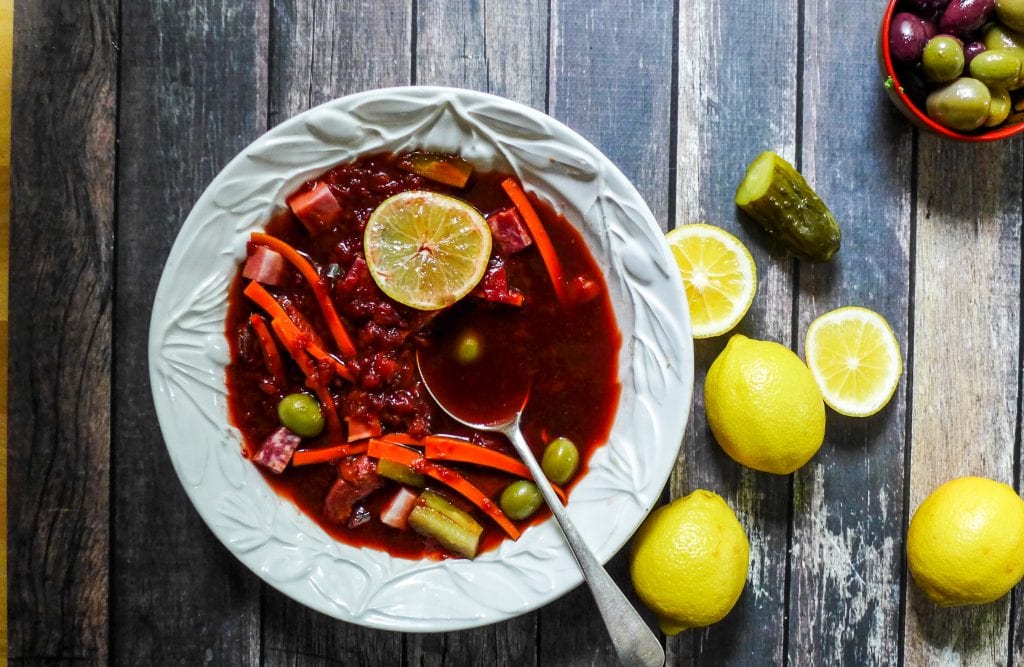Solyanka — the Slavic bouillabaisse a little bit of everything…
To the Western mind, the idea of a workplace canteen seems bizarre, but what the corner bistro is to Frenchmen, the Soviet “stolovaya” or canteen is to any Russian worth his salted cucumbers.
Lunch is the main meal of the day in Russia and always consists of a first course: salad or pickled vegetables, followed by a substantial bowl of hearty Russian soup, then the main course of meat and potatoes, and a dessert. Based in the workplace, the stolovaya serves up a classic Russian lunch at affordable prices to its employees and heralds the lunch hour by pervading the building with cooking smells. In the Soviet era, enterprises, factories, and ministries were all housed in large, self-sufficient buildings, which, combined with the scarcities of small restaurants catering to the lunchtime clientele, made the stolovaya the only option for a midday meal.
When I first arrived in Russia, I worked in a small office in the center of the city: part of a warren of basement-level storerooms. Despite the makeshift nature of building, all of the tenants were entitled to a three-course hot lunch provided by Svetlana Vladislavevna, a rotund woman with a vigorous, coal-black mustache and gold teeth, who operated in a space about as large as she was equipped with one stove ring and a tap, and not a lot else. Nevertheless, her soups were legendary: none of us would have missed coming into the office – for lunch anyway – especially on Friday’s for Svetlana Vladislavevna’s fish solyanka: the Slavic bouillabaisse, clubbed together from the ubiquitous winter stores of Russian salted vegetables including a hearty fish and tomato broth with olives, pickled cucumbers, lemon slices, mushrooms and poached fish chunks.
Sources differ as to the origin of the word “solyanka,” which most people take to mean “salty” from the Russian word “sol” or salt. Another version suggests that the original name may have more to do with the word for village, or “selo.” Like all Russian soups, the recipe is not carved in stone, but rather each town, and each Svetlana Vladislavevna make it their own. Solyanka can also be meat based, with sausages, ham, or beef chunks, as well as marinated mushrooms. The salted cucumbers, olives, and lemon slices give the soup its distinctive tangy and sour taste, and the rest is up to the cook. Perhaps this is why the formal name of the dish, “Sbornaya Solyanka” or “mixed soup” has come into the modern Russian lexicon to mean “mixed bag” or “hotchpotch.”
Fish SolyankaIngredients1000 ml of fish stock 1 bay leaf 450 g of white fish (I used cod) cubed. 3 whole pickled cucumbers 15-20 green olives 20-30 capers 2 whole ripe tomatoes, seeded and cubed 1 Tbl of tomato paste 100 ml of white wine ½ of a large yellow onion, chopped finely 3 cloves of garlic, mashed and chopped finely with salt Maldon Salt and cracked black pepper to taste 1 Tbl of Hungarian paprika 4 Tbl of rassol or pickle juice olive oil ½ a fresh lemon, sliced very thinly chopped dill and scallions for garnish Note: Svetlana Vladislavevna’s recipe calls for butter instead of olive oil, and she used a great deal of it, as well as the Russian pork fat called “salo,” which was responsible for the fine sheen of grease that topped her soup. I’ve toned this down for the more health-conscious palate, but if you want a richer broth, up the olive oil and add a pat or two of butter to the initial sweating process. Directions1. Skim a deep, heavy bottomed soup pot with olive oil and heat until spitting. 2. Sweat the onions and garlic until soft and translucent. 3. Add the wine to the onions. Lower heat to moderate and allow the wine to be completely absorbed by the vegetables. 4. Add the tomato paste and stir until completely absorbed. 5. Add the fish stock, paprika, bay leaves, and tomatoes and heat through. 6. Bring the soup mixture to a simmer and add the pickled cucumbers and capers. Simmer for ten minutes. 7. Reduce heat and add the fish, simmering for five minutes. 8. Remove the bay leaf, and add the olives. Adjust seasoning to taste with salt, pepper and additional paprika. 9. Top with lemon slices and dill and scallion garnish. Priyatnogo Appetita! Recipe Source: https://jennifereremeeva.com |
This piece first appeared in French in La Russie d’Aujourd’hui and Le Figaro on October 10, 2010 under the original title, “Dans le fourre-tout de la villageoise” and a link to the original version can be found here.



One Comment